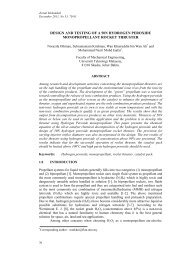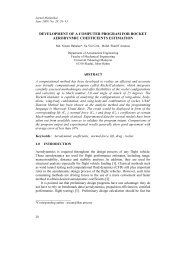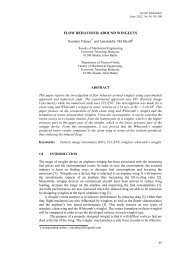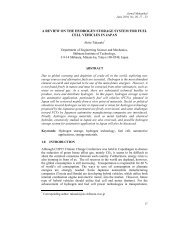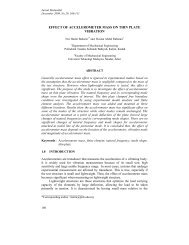Investigation of Gas Swirl Burner Characteristic ... - Jurnal Mekanikal
Investigation of Gas Swirl Burner Characteristic ... - Jurnal Mekanikal
Investigation of Gas Swirl Burner Characteristic ... - Jurnal Mekanikal
You also want an ePaper? Increase the reach of your titles
YUMPU automatically turns print PDFs into web optimized ePapers that Google loves.
<strong>Jurnal</strong> <strong>Mekanikal</strong> December 2011main jet exit, which greatly enhances mixing and causes stabilization <strong>of</strong> the flame. If theeffect <strong>of</strong> this recirculation zone swirl is increased, a jet flame can be reduced in length bya factor <strong>of</strong> five, Chen et. al. [13]. However, another study showed that the reaction aids inthe recirculation vortex formation, since a cold flow test with S g = 1.0 did not show arecirculation vortex, Tangirala et. al. [12]. In another study, some swirl flames with lowenough swirl numbers were associated with lack <strong>of</strong> formation <strong>of</strong> a recirculation vortex.Low swirlconditions apparently have a be study verified that lean flames need to have alower swirl number inorder to be stable, because the swirl velocity can subject thereaction zone to flame strain, which quenches the reaction, Tangirala et. al. [12] and Chenet. al. [13].In conjunction with CFD simulations on the swirl gas burner, a study on thequality <strong>of</strong> the gas mixture in tangential air gasification and a gas swirl burner wasconducted, Agung et. al. [14]. The parameters <strong>of</strong> the measured mixing process were swirlnumber, kinetic turbulent energy, and turbulent intensity. The simulation resultsconcluded that increasing air flow inside the gas burner through tangential flow resultedin a better mixing process. Also, a numerical simulation <strong>of</strong> a turbulent natural gas jetdiffusion flame at a Reynolds (Re) number <strong>of</strong> 9000 in a swirling air stream was reviewed.Results were useful for interpreting the effects <strong>of</strong> swirl inenhancing mixing ratesin the combustion zone and in stabilizing the flame. Theresults showed the generation <strong>of</strong>two recirculating regimes induced by the swirling air stream, Ala [15]. A CFD model wasused to predict the combusting flow field produced by a multi-fuel swirl-stabilizedlaboratory burner with adjustable aerodynamics, which was designed as a scale model <strong>of</strong>an industrial coal burner, Hatziapostolow [16]. Results are reported for two different swirlnumbers and compared to measured velocity and temperature data. The non-premixedcombustion scheme involving the mixture fraction approach was employed and theturbulence-chemistry interaction was accounted for with a Probability Density Functionhaving a β-function shape. For the description <strong>of</strong> turbulence, three turbulence modelswere tested, the standard k-ε model, the RNG k-ε model, and the Realizable k-ε model.Two main problems closely related to the implementation <strong>of</strong> industrial gasburners on ceramic drying, grain and also as a gas potential to partial substitute fuel indiesel engine are:i. Previous testing using the latest gas burner version shows that the quality <strong>of</strong>thegas flame is still low (yellow-red color dominates the gas-flame), as indicatedin Figure 1.Figure 1: <strong>Gas</strong> burner flame with yellow-red color dominationii.Heat release rate <strong>of</strong> the flame, flame performance and measurement <strong>of</strong> productgas flame, such as CO, H 2 , CH 4 , N 2 , CO 2 , are not yet identified.18



